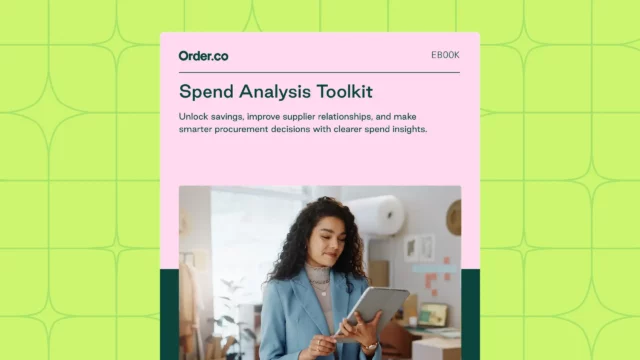Tail Spend Management: How it Affects Profitability

Tail Spend Management: How it Affects Profitability
Tail spend might not seem like a problem when you're looking at individual, low-cost purchases, but it adds up quickly. Unmanaged spend makes it hard to see where your money's going and creates clutter in your procurement process. It can lead to missed savings, fragmented data, and confusion about which purchases and vendors are actually approved.
Thankfully, you can fix all these issues by consolidating vendors and organizing smaller purchases using a clear spend management strategy. With effective tail spend management practices and support from modern tools, you can take back control, make smarter decisions, and protect your bottom line.
Download the free guide: Spend Analysis Toolkit
What is tail spend management?
Tail spend management is the process of identifying, controlling, and optimizing the many small, often unplanned purchases buyers make across a large number of suppliers. While these purchases typically involve about 80% of your vendors, they usually account for only around 20% of your company's total spend. Even though each transaction is low value, collectively they represent a major opportunity to reduce costs and improve efficiency—especially since this spend often happens outside centralized procurement processes.
Organizations often define and analyze tail spend using both:
- The Pareto Principle (80/20 rule): Identifying suppliers that represent 80% of your vendor relationships but only 20% of your total spend
- A set monetary threshold: Setting a spend limit, like $10,000 per supplier, and excluding anything below it from strategic management
Tail spend is usually a subset of indirect spend, but it can also include direct purchases. Managing this type of spending means uncovering all patterns of unplanned or inefficient buying, such as:
- Duplicate charges for administrative tools or software subscriptions
- Ad hoc office supply orders from multiple vendors outside of procurement oversight
- Uncontracted maintenance repairs
- Consulting charges from experts hired by different departments
- Credit card processing fees spread across multiple providers
By analyzing these patterns through frameworks like the 80/20 rule or company spend thresholds, you can expose redundant internal processes, unnecessary suppliers, and hidden costs.pending, indirect procurement is often one of the largest expense categories for businesses and the most in need of strong budgetary controls.
Why do companies often overlook tail spend?
Tail spend is easy to miss because it's made up of small, scattered purchases that often fall outside structured procurement processes. These transactions are typically urgent spot buys or such low-value purchases that they bypass typical oversight.
While it makes sense for procurement professionals to primarily focus on high-value and strategic spending categories, ignoring the tail means missing out on opportunities to cut costs, negotiate better contracts, and simplify vendor management.
Enforcing procurement processes across departments and locations also becomes difficult, leading to challenges like:
- Managing hundreds of small suppliers
- Lacking visibility into current spend
- Operating without strategic forecasting for low-value transactions
- Struggling to implement cross-functional collaboration between procurement and other teams
Order.co simplifies tail spend management by automating PO creation, vendor approvals, and spend tracking, giving you control over a part of your procurement process that might otherwise go ignored.
Benefits of managing tail spend effectively
Taking charge of your small, unmanaged purchases helps improve savings, visibility, and compliance across your entire organization. Here are some of the major advantages of a focused tail spend management approach:
- More cost-saving opportunities: Improving procurement management and eliminating maverick spend (unauthorized or off-contract purchases) helps you consolidate purchasing across departments. Bundling recurring needs with a smaller group of preferred vendors can also unlock better pricing and reduce waste.
- Greater visibility, measurement, and spend control: Gaining control over your tail spend strategy, implementing spend under management, and using only approved processes and vendors ensures expenses are tracked and measurable.
- Reduced risk and improved compliance: Implementing clear policies to prevent tail purchases helps mitigate the risks of fraud, noncompliant partners, and unapproved suppliers while centralizing your procurement process for more consistent oversight.
- Enhanced spend and operational efficiency: Automating tail spend management eliminates manual tasks and increases productivity. A centralized platform can manage expense tracking, vendor and item approvals, and purchase order execution—all in one place.
- Improved procurement visibility and strategy: Consolidating procurement data, such as vendor performance, purchase history, and delivery records, provides a strong foundation for budgeting, forecasting, and spend analysis. This helps you negotiate more favorable deals with vendors, reduce unnecessary tail spend, and improve your bottom line.
- Improved regulatory oversight: Documenting and tracking critical steps, vendor certifications, and purchase approvals helps ensure compliance in highly regulated industries like healthcare, law, and finance.
With the right support, you can turn tail spend from a challenge into a manageable part of your overall procurement efficiency. Order.co gives you the tools to automate procurement workflows, improve spend visibility, and enforce compliance across every purchase.
How technology transforms tail spend management
Modern technology brings fragmented tools and processes together into a unified procurement strategy, providing clear visibility across your operations, vendor relationships, and contracts.
Today's solutions make tail spend management easier, more accurate, and more efficient. Automated workflows, AI analytics, and centralized procurement views help your team handle purchases, logistics, and invoicing with precision.
Automated workflows: Eliminating manual bottlenecks

Automated workflows help eliminate the burdens of managing an endless list of manual tasks and juggling emails and spreadsheets for daily procurement. With the help of technology, teams can submit approval requests, create purchase orders (POs), trigger payments, and track deliveries with little to no manual effort.
Centralized visibility into all your procurement activities provides the analytics you need to identify opportunities to reduce costs, improve purchasing efficiency, and strengthen vendor relationships. Choosing a procurement platform like Order.co that integrates with accounting solutions like QuickBooks, Oracle NetSuite, and Sage Intacct can help you take control of your tail spend and improve your entire procurement process.
AI-driven analytics: Turning spend data into strategy
AI-powered spend analytics help you spot overlooked spending and turn it into helpful insights. When you leverage AI for data collection and tail spend analysis, you can identify spending patterns, reduce waste, and find ways to consolidate tail spend purchases with a smaller group of vendors.
For example, when Mediaplanet used AI technologies within Order.co, it saved an average of 8.8% on purchases by automatically scanning for product and vendor alternatives to reduce costs.
With the help of AI, tail spend management transforms from a time-consuming task to a value-adding opportunity. You can quickly pinpoint cost savings by identifying vendor overcharges, finding better contract opportunities, and discovering patterns you might have missed on your own.
5 steps to optimize tail spend
By combining technology with best practices, you can take full advantage of the benefits of tail spend management. Here's how to get started.
1. Create a clear vendor spend threshold
Begin by defining what tail spend means for your organization. Then use the Pareto principle as a guideline (where roughly 80% of suppliers account for about 20% of spend) to identify tail spend vendors. It's also smart to set a practical monetary threshold that fits your unique spending profile.
For example, you might classify any vendor with less than $35,000 in annual purchases as part of your tail spend. From there, look for opportunities to consolidate these smaller purchases under preferred suppliers to negotiate better contracts.
By categorizing tail spend based on vendor and total spend, you give your team clear parameters for managing these purchases. Spend management solutions like Order.co offer built-in spend analysis and reporting tools that can help you identify and analyze tail spend opportunities in one centralized place.
2. Align purchasing policies with automation
Once you’ve defined your thresholds and tail spend goals, pair them with clear procurement policies that are consistently enforced. One of the most common reasons tail spend improvement efforts fall short is because policies exist on paper but aren’t upheld in practice.
Software can help you close that gap. Automating policy enforcement through approved vendors and suppliers, purchasing controls, and audit logs makes it easier to hold teams accountable and ensure purchases follow established expectations.
Tail spend strategies can still fail if they’re overly complex or poorly communicated. Set SMART goals, communicate policies across departments, and choose tools that simplify procurement to increase adoption and success.
3. Consolidate or renegotiate supplier contracts
Dealing with dozens or hundreds of small vendors adds unnecessary complexity to your procurement process. It also limits your ability to negotiate favorable terms, track performance, or maintain compliance.
By consolidating purchases under a smaller set of preferred suppliers, you simplify contract management and create opportunities for volume discounts and stronger vendor relationships. A centralized view of your vendor partnerships also helps your procurement team with decision-making, forecasting, and finding significant savings opportunities.
4. Use analytics to spot spend patterns
Improving your tail spend doesn't end in a few sessions. You may have gotten it under control today, but maintaining healthy procurement operations means continuously reviewing where your money is going.
Procurement analytics give you the visibility to spot inefficiencies, like redundant supplier relationships or unexpected spikes in tail spend. AI-powered insights can help you place more informed orders, align with preferred vendors, and make faster, more informed decisions. Whether multiple teams are buying the same items from different suppliers or tail purchases are trending up, your data can help you course correct quickly.
5. Implement feedback loops for continuous improvement
To keep improving your process over time, create a feedback program that includes key teams and stakeholders.
Start with regular reviews of your tail spend metrics, such as cost savings, supplier consolidation progress, or policy adoption rates. Supplement these reviews with internal check-ins or short surveys to uncover overlooked issues. Ask questions like:
- Are our purchasing and vendor guidelines clear?
- Is the approval process easy to follow?
- Does the order software meet your needs?
Creating space for input helps ensure that your tail spend management strategy is practical, efficient, and aligned with how your team actually works.
Strengthen procurement with an automated approach
Automating your spend management doesn’t just help minimize unmanaged purchases. It also brings more visibility, control, and efficiency to your entire procurement process.
That's exactly what happened when WeWork partnered with Order.co. The coworking company needed to reduce invoice volume, simplify manual workflows, and gain visibility into companywide spending. With the help of a centralized software solution, it achieved clarity and control over every transaction.
“Now, we know exactly what we are purchasing and how much every product costs.”—Kyle Ingerman, Finance Transformations Senior Manager, WeWork
A modern procurement platform can help you manage tail spend while improving how your team purchases, approves, and tracks expenditures. With Order.co, you can:
- Guide team purchases through a curated, preapproved product catalog
- Set and enforce custom budgets at the department or location level
- Build approval workflows to maintain control over every purchase
- Monitor spend in real time with centralized reporting
- Maintain transparency and accountability with detailed audit trails
Schedule a demo today to see how Order.co can help you eliminate tail spend and improve the entire procurement process.
Get started
Schedule a demo to see how Order.co can simplify buying for your business
"*" indicates required fields



